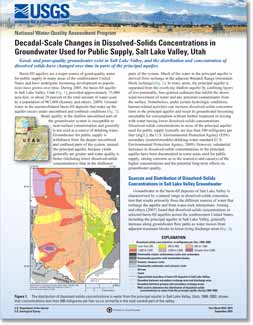 Introduction Introduction
Basin-fill aquifers are a major source of good-quality water for public supply in many areas of the southwestern United States and have undergone increasing development as populations have grown over time. During 2005, the basin-fill aquifer in Salt Lake Valley, Utah, provided approximately 75,000 acre-feet, or about 29 percent of the total amount of water used by a population of 967,000. Groundwater in the unconsolidated basin-fill deposits that make up the aquifer occurs under unconfined and confined conditions. Water in the shallow unconfined part of the groundwater system is susceptible to near-surface contamination and generally is not used as a source of drinking water. Groundwater for public supply is withdrawn from the deeper unconfined and confined parts of the system, termed the principal aquifer, because yields generally are greater and water quality is better (including lower dissolved-solids concentrations) than in the shallower parts of the system. Much of the water in the principal aquifer is derived from recharge in the adjacent Wasatch Range (mountain-block recharge). In many areas, the principal aquifer is separated from the overlying shallow aquifer by confining layers of less permeable, fine-grained sediment that inhibit the downward movement of water and any potential contaminants from the surface. Nonetheless, under certain hydrologic conditions, human-related activities can increase dissolved-solids concentrations in the principal aquifer and result in groundwater becoming unsuitable for consumption without treatment or mixing with water having lower dissolved-solids concentrations. Dissolved-solids concentrations in areas of the principal aquifer used for public supply typically are less than 500 milligrams per liter (mg/L), the U.S. Environmental Protection Agency (EPA) secondary (nonenforceable) drinking-water standard. However, substantial increases in dissolved-solids concentrations in the principal aquifer have been documented in some areas used for public supply, raising concerns as to the source(s) and cause(s) of the higher concentrations and the potential long-term effects on groundwater quality.
|
Part or all of this report is presented in Portable Document Format (PDF); the latest version of Adobe Reader or similar software is required to view it. Download the latest version of Adobe Reader, free of charge. |